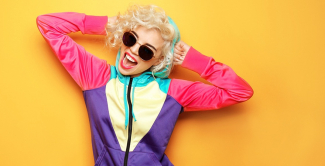Feeling blue? Tickled pink? How colour affects our emotions
Colour is everywhere, and whether you know it or not, it has a huge influence on how we experience the world.
Colour can trigger emotions, influence our decisions, and even change the taste of our food. But how does it work? And what effect does it have on how we feel and behave? We’ve asked in-house optometrist, Roshni, to give us the expert scoop.
How do we see colour?
How we perceive colour comes down to light particles – called photons – bouncing off objects and into our eyes.
When light hits an object – say, an orange – the object absorbs some of the light and reflects the rest of it into the human eye. We perceive only the reflected colour. Light-sensitive cells within the eye (called photoreceptors) transmit messages to the brain, which produces the familiar sensations of colour.
Do we all see colours in the same way?
For many of us, there’s no debate – the grass is green. But it turns out, we don't all recognise colours in the same way. Some people have trouble distinguishing between certain colours – a condition known as a colour deficiency – due to a defect in the light-sensitive cells in the eye. Others may have a heightened sensitivity to colour.
Some experts have suggested that how we see colour can be influenced by factors, such as experience, mood, culture, gender, and even age. For example, red represents good luck in Asia but evokes sadness in South Africa as it’s the colour of mourning.
Although there’s a huge amount of variability in how we perceive colour, some colours do carry universal meanings and emotions.

Common colour meanings

Blue calls to mind feelings of calmness and serenity, perhaps drawn from its association with the sea and sky. It’s a colour of stability and trust and is a universal favourite of industries, like finance or tech, and institutions like the NHS or police force. Blue is believed to boost productivity and aid concentration. But it can also represent sadness and loneliness, hence having 'the blues'.
Yellow is for happiness, hope and spontaneity. Some research has shown that children prefer warmer, brighter colours, such as yellow because they’re full of joy and positivity. However, when it’s too bright, it can overstimulate the eyes and cause dizziness and nausea. This might explain why it’s almost never used on transportation – especially aeroplanes.
Orange represents creativity, adventure, enthusiasm and wellbeing. Orange combines the warmth of red with the playfulness of yellow. It brings energy and is often associated with health and vitality, perhaps given its obvious link to vitamin C.
Red represents passion, energy, aggression and danger. Humans are hardwired to pay attention to fiery red because it was a natural warning in primitive times. Red is perhaps the most emotionally powerful colour – so much so that it’s been shown to cause physiological reactions, such as increasing heart rate and stimulating appetite. The popular theory is that fast-food chains use red in their restaurants because it triggers hunger.
Green is a symbol of nature, growth and balance – but also wealth, envy and greed. It’s calming, stress-relieving and invigorating, and has been shown to get the creative juices flowing. Guests waiting to appear on TV often sit in "green rooms" to relax. Hospitals also use green to help reduce anxiety in patients.
Purple is an intriguing colour that combines the heat of red with the serenity of blue. Because of its associations with royalty, purple evokes wealth and luxury. Light purple has more feminine energy, while dark purple often represents sadness or frustration.
White represents purity and innocence and has long been associated with wedding ceremonies. Its minimal aesthetic also conveys an air of cleanliness, freshness and simplicity. For example, hospitals use white to create a sense of cleanliness. White is also associated with a blank slate, symbolising new beginnings.
So there you have it, some of the ways colour can affect our emotions and behaviour. The next time you find yourself sitting in a waiting room, or lured into a fast-food restaurant, consider the colours around you.



